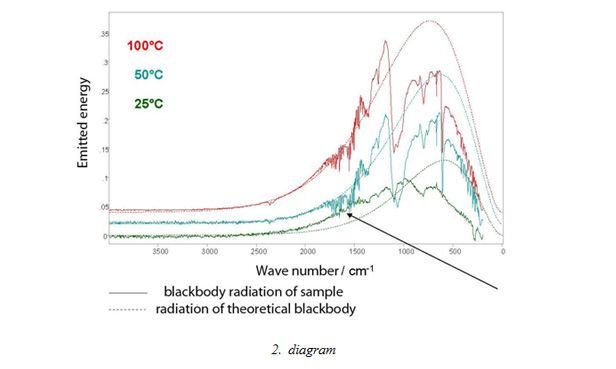


Infra-red spectroscopy (FTIR) examination of „YULE” mineral composit ceramie
We have examined the YULE mineral composit ceramie what we have received from the NIELS R&D Ltd. firm for the infra-red (IR) his spectrum in a reflection and emission mode of operation. The reflection uptakes gave a footing onto the mineral combination of the YULE material, that is identified an alumino-silicon.
We received a more interesting and surprising result emission IR in the case of measurements. The emission measurements are made in such a way generally that we warm up the sample. The sample gets into a vibrational aroused state hereby, that than issues characteristic radiation. Because the environment and the detector also 25°C, it is necessary to warm up the sample for a taller temperature at it is, that let us receive an emission spectrum. Opposite the general experience the from the YULE sample we received a weak emission sign which can be detected on 25°C already. The 1. diagram exemplifies this.

The YULE composit ceramie on 25°C emits IR radiation in a wave province of 980-2500 cm-1 what can be measured. We made the comparison with the energy spectrum of the theoretical blackbody.
It is possible to explain this surprising phenomenon by means of the under mentioned ones: presumably in the longer wavelength swallowed radiant energy the sample emits it in a province on the shorter wavelength. This phenomenon in the visible and ultra-violet province we call photoluminescence, what may be a most rare phenomenon in the infra-red province on the other hand.
It supports this interpretation, that in the province of far infra-red wave (under 600 cm-1 wavelength) the vibrational states most easily can be stimulated, so the filled state of standards may be considerable. The substance emits this energy like „source of heat” on province of mid-wavelength infrared what was picked up from environment even on 25°C.

We examined the YULE sample emission IR spectrum on 50°C and it on 100°C (2. diagram). As on the 2. diagram can be seen, that between the emission of the theoretical blackbody and the sample largest the difference on 25°C. The significance of the honed seen effect decreases on taller temperatures, the left-wing landing branches of the experiment and the blackbody coincide fairly much, on particularly 100°C.
Our examinations until now justify that the heat effect of sample of YULE is especially well exploitable on neighborhood of room temperature (25-35 °C).
Dr. Mink János
university professor